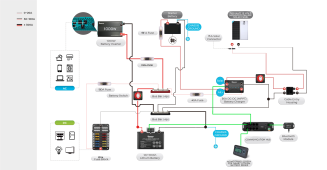Dustmopper
New Member
- Joined
- Sep 1, 2022
- Messages
- 12
Hello,
I basically took the existing Renogy Camper Van Diagram and downscaled it a little for my needs (only one battery, smaller inverter, only 200W solar, smaller DC-DC charger). This set up is for a small camper van, Nissan NV200.
I'd love it if someone with a trained eye could take a look at my fuse sizing/positioning. The manual for the 30A DC-DC charger recommends 40A out and 45A fuse in.
My wire sizing plan is as follows:
I also added a DC on/off switch coming in from the solar which is not in the Renogy diagram.
Please let me know if you have any comments or suggestions, I would really appreciate it!
Thanks!

I basically took the existing Renogy Camper Van Diagram and downscaled it a little for my needs (only one battery, smaller inverter, only 200W solar, smaller DC-DC charger). This set up is for a small camper van, Nissan NV200.
I'd love it if someone with a trained eye could take a look at my fuse sizing/positioning. The manual for the 30A DC-DC charger recommends 40A out and 45A fuse in.
- Is a 15A fuse at the 200W solar panel right?
- 120A fuse to the 1000W inverter?
- 120A fuse to the 100A breaker?
- Should I get a terminal block fuse right at the 100ah battery? If so what size?
My wire sizing plan is as follows:
- 10 AWG for everything solar
- 4 AWG from battery to bus bars
- 4 AWG from bus bars to inverter
- 6 AWG for everything else
I also added a DC on/off switch coming in from the solar which is not in the Renogy diagram.
Please let me know if you have any comments or suggestions, I would really appreciate it!
Thanks!



